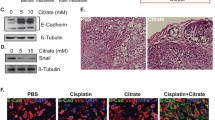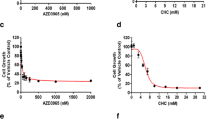Summary
Cellular metabolic alterations are now well described as implicated in cancer and some strategies are currently developed to target these different pathways. In previous papers, we demonstrated that a combination of molecules (namely alpha-lipoic acid and hydroxycitrate, i.e. Metabloc™) targeting the cancer metabolism markedly decreased tumor cell growth in mice. In this work, we demonstrate that the addition of capsaicin further delays tumor growth in mice in a dose dependant manner. This is true for the three animal model tested: lung (LLC) cancer, bladder cancer (MBT-2) and melanoma B16F10. There was no apparent side effect of this ternary combination. The addition of a fourth drug (octreotide) is even more effective resulting in tumor regression in mice bearing LLC cancer. These four compounds are all known to target the cellular metabolism not its DNA. The efficacy, the apparent lack of toxicity, the long clinical track records of these medications in human medicine, all points toward the need for a clinical trial. The dramatic efficacy of treatment suggests that cancer may simply be a disease of dysregulated cellular metabolism.





Similar content being viewed by others
References
Schwartz L, Abolhassani M, Guais A, Sanders E, Steyaert JM, Campion F, Israel M (2010) A combination of alpha lipoic acid and calcium hydroxycitrate is efficient against mouse cancer models: preliminary results. Oncol Rep 23:1407–1416. doi:10.3892/or_00000778
Abolhassani M, Guais A, Sanders E, Campion F, Fichtner I, Bonte Jacques, Baronzio G, Fiorentini G, Israel M, Schwartz L (2011) Screening of well-established drugs targeting cancer metabolism: reproducibility of the efficacy of a highly effective drug combination in mice. Invest New Drugs. doi:10.1007/s10637-011-9692-7, In press
Israël M, Schwartz L (2011) The metabolic advantage of tumor cells. Mol Cancer 10:70. doi:10.1186/1476-4598-10-70
Warburg O (1956) On the origin of cancer cells. Science 123:309–14
Gatenby RA, Gillies RJ (2004) Why do cancers have high aerobic glycolysis? Nat Rev Cancer 4:891. doi:10.1038/nrc1478
Bui T, Thompson B (2006) Cancer’s sweet tooth. Cancer Cell 9:419–20. doi:10.1016/j.ccr.2006.05.012
Gatenby RA, Gawlinski ET, Gmitro AF, Kaylor B, Gillies RJ (2006) Acid-mediated tumor invasion: a multidisciplinary study. Cancer Res 66:5216–5223. doi:10.1158/0008-5472.CAN-05-4193
Pelicano H, Martin DS, Xu RH, Huang P (2006) Glycolysis inhibition for anticancer treatment. Oncogene 25:4633–4646. doi:10.1038/sj.onc.1209597
Moreno-Sanchez R, Rodriguez-Enriquez S, Marin-Hernandez A, Saavedra E (2007) Energy metabolism in tumor cells. FEBS J 274:1393–1418. doi:10.1111/j.1742-4658.2007.05686.x
Michelakis ED, Sutendra G, Dromparis P, Webster L, Haromy A, Niven E, Maguire C, Gammer TL, Mackey JR, Fulton D, Abdulkarim B, McMurtry MS et al (2010) Metabolic modulation of glioblastoma with dichloroacetate. Sci Transl Med 2:31ra34. doi:10.1126/scitranslmed.3000677
Berkson BM, Rubin DM, Berkson AJ (2006) The long-term survival of a patient with pancreatic cancer with metastases to the liver after treatment with the intravenous alpha-lipoic acid/low-dose naltrexone protocol. Integr Cancer Ther 5:83–89. doi:10.1177/1534735405285901
Berkson BM, Rubin DM, Rubin AJ (2009) Revisiting the alpha-LA/N (alpha-lipoic acid/low dose naltrexone) protocol for people with metastatic and nonmetastatic pancreatic cancer: a report of 3 new cases. Integr Cancer Ther 8:416–422. doi:10.1177/1534735409352082
Pardee TS, Levitan D, Hurd D (2011) Altered mitochondrial metabolism as a target in acute myeloid leukemia. ASCO Congress Poster
Lee K, Khaira D, Rodriguez R, Maturo C, O’Donnell K, Shorr R (2011) Case study: long-term stable disease of stage IV pancreatic neuroendocrine tumors and without significant adverse effect by CPI-613, an investigational novel anti-cancer agent. Case Study Case Report 1:137–145
Guais A, Baronzio G, Sanders E, Campion F, Mainini C, Fiorentini G, Montagnani F, Behzadi M, Schwartz L, Abolhassani M (2012) Adding a combination of hydroxycitrate and lipoic acid (METABLOC™) to chemotherapy improves effectiveness against tumour development: experimental results and case report. Invest New Drugs 30:200–211. doi:10.1007/s10637-010-9552-x
Oberg K (2010) Antitumor effect of octreotide LAR, a somatostatin analog. Nature Rev Endocrinol 6:188–189. doi:10.1038/nrendo.2010.3
Kang HJ, Soh Y, Kim MS, Lee EJ, Surh YJ, Kim HRC, Kim SH, Moon A (2003) Roles of JNK-1 and p38 in selective induction of apoptosis by capsaicin in ras-transformed human breast epithelial cells. Int J Cancer 103:475–482. doi:10.1002/ijc.10855
Ito K, Nakazato T, Yamato K, Miyakawa Y, Yamada T, Hozumi N, Segawa K, Ikeda Y, Kizaki M (2004) Induction of apoptosis in leukemic cells by homovanillic acid derivative, capsaicin, through oxidative stress: implication of phosphorylation of p53 at Ser-15 residue by reactive oxygen species. Cancer Res 64:1071–1078. doi:10.1158/0008-5472.CAN-03-1670
Thoennissen NH, O’Kelly J, Lu D, Iwanski GB, La DT, Abbassi S, Leiter A, Karlan B, Mehta R, Koeffler HP (2010) Capsaicin causes cell-cycle arrest and apoptosis in ER-positive and –negative breast cancer cells by modulating the EGFR/HER-2 pathway. Oncogene 29:285–296. doi:10.1038/onc.2009.335
Choi CH, Jung YK, Oh SH (2010) Autophagy induction by capsaicin in malignant human breast cells is modulated by p38 and extracellular signal-related mitogen-activated protein kinases and retards cell death by suppressing endoplasmic reticulum stress-mediated apoptosis. Mol Pharmacol 78:114–125. doi:10.1124/mol.110.063495
Morré DJ, Chueh PJ, Morré DM (1995) Capsaicin inhibits preferentially the NADH oxidase and growth of transformed cells in culture. Proc Nat Acad Sci USA 92:1831–1835
Sanchez AM, Sanchez MG, Malagarie-Cauenave S, Olea N, Diaz-Laviada I (2006) Induction of apoptosis in prosstate tumor PC-3 cells and inhibitiion of xenograft prostate tumor growth by the vanilloid capsaicin. Apoptosis 11:89–99. doi:10.1007/s10495-005-3275-z
Bhutani M, Pathak A, Nair AS, Kunnumakkara AB, Guha S, Sethi G, Aggarwal B (2007) Capsaicin is a novel blocker of constitutive and interleukin-6-inducible STAT3 activation. Clin Cancer Res 13:3024–3032. doi:10.1158/1078-0432.CCR-06-2575
Yang ZH, Wang XH, Wang HP, Hu LQ, Zheng XM, Li SW (2010) Capsaicin mediates death in bladder cancer T24 cells through reactive oxygen species production and mitochondrial polarization. Urology 75:735–741. doi:10.1016/j.urology.2009.03.042
Wang HM, Chueh PJ, Chang SP, Yang CL, Shao KN (2009) Effect of capsaicin on tNOX (ENOX2) protein expression in stomach cancer cells. Biofactors 34:209–217
Nagy I, Santha P, Jancso G, Urban L (2004) The role of the vanilloid (capsaicin) receptor (TRPV1) in physiology and pathology. Eur J Pharmacol 500:351–369. doi:10.1016/j.ejphar.2004.07.037
White JPM, Urban L, Nagy I (2011) TRPV1 function in health and disease. Curr Pharm Biotechnol 12:130–44
Mori A, Lehmann S, O’Kelly J, Kumagai T, Desmond JC, Pervan M, McBride WH, Kizaki M, Koeffler HP (2006) Capsaicin, a component of red peppers, inhibits the growth of androgen-independent, p53 mutant prostate cancer cells. Cancer Res 66:3222–3229. doi:10.1158/0008-5472.CAN-05-0087
Hail N Jr, Lotan R (2002) Examining the role of mitochondrial respiration in vanilloid-induced apoptosis. J Nat Cancer Inst 94:1281–1292. doi:10.1093/jnci/94.17.1281
Hail N Jr, Lotan R (2009) Cancer chemoprevention and mitochondria: targeting apoptosis in transformed cells via the disruption of mitochondrial bioenergenetics/redox state. Mol Nutr Food Res 53:49–67. doi:10.1002/mnfr.200700527
Wolvertang EJ, Larm JA, Moutsoulas P, Lawen A (1996) Apoptosis induced by inhibitors of the plasma membrane NADH-oxidase involves Bcl-2 and calcineurin. Cell Growth Differ 7:1315–1325
Macho A, Lucena C, Calzado MA, Blanco M, Donnay I, Appendino G, Munoz E (2000) Phorboid 20-homovanillates induce apoptosis through a VR1-independent mechanism. Chem Biol 7:483–492. doi:10.1016/S1074-5521(00)00132-0
Herst PM, Tan AS, Scarlett DG, Berridge MV (2004) Cell surface oxygen consumption by mitochondrial gene knockout cells. Biochim Biophys Acta 1656:79–87. doi:10.1016/j.bbabio.2004.01.008
Prata C, Grasso C, Loizzo S, Sega FVD, Caliceti C, Zambonin L, Fiorentini D, Hakim G, Berridge MV, Landi L (2010) Inhibition of trans-plasma membrane electron transport: a potential anti-leukemic strategy. Leuk Res 34:1630–1635. doi:10.1016/j.leukres.2010.02.032
Wilkinson F, Kim C, Cho N, Chueh PJ, Leslie S, Moya-Camarena S, Morré DM, Morré DJ (1996) Isolation and identification of a protein with capsaicin-inhibited NADH oxidase activity from culture media condition by growth of HeLa cells. Arch Biochem Biophys 336:275–282
Morré DJ, Caldwell S, Mayorga A, Wu LY, Morré DM (1997) NADH oxidase activity from sera altered by capsaicin is widely distributed among cancer patients. Arch Biochem Biophys 342:224–230
Chueh PJ (2000) Cell membrane redox systems and transformation. Antioxid Redox Signal 2:177–187
Chueh PJ, Wu LY, Morré DM, Morré DJ (2004) tNOX is both necessary and sufficient as a cellular target for the canticancer activity of capsaicin and the green tea catechin (-)-epigallocatechin-3-gallate. Biofactors 20:249–263
Morré DJ, Chueh PJ, Yagiz K, Balicki A, Kim C, Morré DM (2007) ECTO-NOX target for the anticancer isoflavene phenoxodiol. Oncol Res 16:299–312
De Luca T, Morré DM, Zhao H, Morré DJ (2005) NAD+/NADH and/or CoQ/CoQH2 ratios from plasma membrane electron transport may determine ceramide and sphingosine-1-phosphate levels accompanying G1 arrest and apoptosis. Biofactors 25:43–60
Sanchez AM, Malagarie-Cazenave S, Olea N, Vara D, Chileoches A, Diaz-Laviada I (2007) Apoptosis induced by capsaicin in prostate PC-3 cells involves ceramide accumulation, neutral sphingomyelinase, and JNK activation. Apoptosis 12:2013–2024. doi:10.1007/s10495-007-0119-z
Lau A, Villeneuve NF, Sun Z, Wong PK, Zhang DD (2008) Dual roles of Nrf2 in cancer. Pharmacol Res 58:262–270. doi:10.1016/j.phrs.2008.09.003
Bode AM, Dong Z (2011) The two faces of capsaicin. Cancer Res 71:2809–2814. doi:10.1158/0008-5472.CAN-10-3756
Surh YJ, Lee SS (1996) Capsaicin in hot chilli pepper: carcinogen, co-carcinogen or anticarcinogen. Food Chem Toxicol 34:314–316. doi:10.1016/0278-6915(95)00108-5
Chou CC, Wu YC, Wang YF, Chou MJ, Kuo SJ, Chen DR (2009) Capsaicin-induced apoptosis in human breast cancer MCF-7 cells through caspase-independent pathway. Oncol Rep 21:665–671. doi:10.3892/or_00000269
Macho A, Sancho R, Minassi A, Appendino G, Lawen A, Munoz E (2003) Involvement of reactive oxygen species in capsaicinoid-induced apoptosis in transformed cells. Free Rad Res 37:611–619
Acknowledgments
We acknowledge the help of Edward Sanders. The studies were performed by Nosco Pharmaceuticals (France). This work was funded by Biorébus.
Conflict of interest
METABLOC is a trade mark of Biorébus.
AG is an employee of Biorébus. The other authors declare that they have no competing interests.
Author information
Authors and Affiliations
Corresponding author
Electronic supplementary material
Below is the link to the electronic supplementary material.
Supplementary Fig. 1
Summary statistics used when comparing outcomes between mice treated and not treated. Two statistics were used for analyzing in vivo tumor growth and response to treatment. Left - T/C%, the ratio of change over time in median tumor volume in percent for groups treated with capsaicin and for control groups; Right - Rp, the ratio dividing successes by failures of treatment with capsaicin across all possible pairs of mice, one coming from a treated group and the other from a control group. A ratio Rp = St/Ft lower than 1.0 would mean that the volume of the tumor is likely to increase more often in the treated group than in the control group (less successes than failures); a ratio larger than 1.0 would mean that the volume of the tumor is likely to increase less often in the treated group than in the control group (more successes than failures). The TVI (tumor volume increase) is obtained by subtracting the reference volume measured on the first day of treatment. (PDF 12 kb)
ESM 1
(DOC 73.0 kb)
Rights and permissions
About this article
Cite this article
Schwartz, L., Guais, A., Israël, M. et al. Tumor regression with a combination of drugs interfering with the tumor metabolism: efficacy of hydroxycitrate, lipoic acid and capsaicin. Invest New Drugs 31, 256–264 (2013). https://doi.org/10.1007/s10637-012-9849-z
Received:
Accepted:
Published:
Issue Date:
DOI: https://doi.org/10.1007/s10637-012-9849-z




